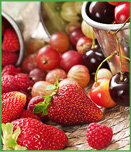Growing fruit is a rewarding process. They are a long-term project and you should carefully plan their placement. The fruit trees like apples, peaches, cherry, and plum all produce a spectacular display when they flower and should be considered into the design of your garden. They make excellent shade trees as well. The smaller fruits like blueberries can be treated as a flowering shrub and will fit in with forsythias and spireas. Grapes do not need to be kept in a vegetable garden and will give a spectacular display if they are hanging from a covered walkway or arbor. It is a great way to cover up an old fence or beautify a corner of a patio in need of uplift.
Few gardeners have room to set aside an area to serve as an orchard and therefore your tree’s location in the backyard needs to be well thought out first. These plants can attain unexpected heights, so make sure you allow ample room for your tree to grow. Make sure the ground is well worked over with compost and manure. All trees need a well-draining soil as they do not like to sit in water. The soil should be loose and not hard-packed clay so the roots can grow rapidly, establishing support for the growing tree. Wait for the soil to settle before planting. For most of the United States and Canada, it is recommended to plant fruit trees in the springs; in the South and Southwest, it is possible to plant in the fall or early winter.
Before placing the tree in the hole, be sure to fill it with water and let it to drain completely. This soaks the ground around where the roots will be growing, but be sure to not plant the tree in any standing water or the roots may rot. After planting the fruit trees, surround the trunk with a layer of mulch to preserve moisture and provide nutrients over time.
Fruit trees are discussed within this chapter but the information is directed at those gardeners with fruit trees already growing in their garden or yard. If you are going to plant fruit trees, be sure to speak with the experts at your nursery center to choose the best variety for the location you have available. There are many dwarf varieties you can include if space in your garden is limited.
Apple Trees
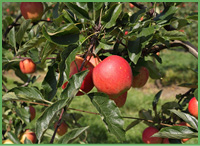
There are both early- and late-blooming apple varieties. A general rule is to plant two together for pollination purposes. If you want the apples to appear even earlier for your variety, plant feverfew and dandelions around the base of the tree because they will attract bees and other major pollinators to your tree’s blossoms.
Good companion planting practice is to plant nitrogen fixers at the base of the tree like beans, clover (mow before flowering to keep it in control), and peas, which will climb up the tree. Another good companion for apple trees is chives; although it takes three years, it will eventually prevent scab on the tree. Borage helps bring in the bees, adds trace minerals to the soil, and has the ability to increase the tree’s resistance to pests and plant disease. Nasturtiums will climb up the trunk and help to repel codling moths. Foxglove is supposed to protect the tree from disease while helping the fruit last longer once picked. Wallflower and apples both grow better when together. Other good companions include onion, marigold, alyssum, pansy, garlic, and sweet woodruff. Do not plant potatoes close to the apple trees as they become more susceptible to blight when close to apple trees. Bad companions include walnut trees and hawthorn.
Apricot
Apricot trees are great for back yard gardeners. They are all self-pollinating but can still benefit from being planted in pairs if you have room. They can be pruned nicely to make them easy to pick and the fruit is always sweet. Like the apple tree, they do better with nitrogen-fixing plants like beans, peas, and clover planted at the base of the tree. If you plant clumps of basil, tansy, or wormwood around the base of the trees, they will reduce the number of fruit flies considerably. These herbs have a strong scent that flies do not like so they will deter the flies from the fruit. Nasturtiums make another good companion plant for the same reason. Other good companion plants include asparagus, pansy, borage, chives, and garlic.
Bad companions include tomatoes because the roots of the apricot and tomato do not react well when close by. As well, keep oats and potatoes away from apricot trees.
Blackberries
Plant blackberries in a full-sun location in well-drained soil. They will tolerate some shade but will produce more fruit in the sun. Dig over the bed, and make sure it is slightly acidic – anywhere from 5.5 to 7 pH. Plant early in the spring approximately 4 feet apart with the rows 10 feet apart. Cut the bushes back to 6 inches above the ground and water well. Apply a thick mulch and leave to grow. During the time they are producing fruit, keep them well watered.
Tansy is great at repelling flies and ants, although you may want to plant in containers as it will take over quickly. If you keep several pots of tansy around your berry patch, the blackberries will grow faster and bigger. Consider planting mulberries, elderberries, or chokecherries close by to lure the birds away from the blackberries. Do not plant raspberries close to the blackberries to avoid cross pollination.
Blueberries
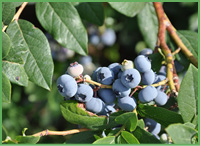
Blueberries are easy to grow throughout most of North America. They do need an acidic soil around a pH of 4 to 5. There are several varieties to choose from – some early- and some late-producing, as well as some that are low-growing and others that are high-growing bushes; you should be able to find one that suits your garden and your location. Blueberries are self-pollinating but they will grow more and produce larger berries if you plant two different varieties to cross pollinate. Prepare the soil well with pine needles to make the ground more acidic, and add peat moss and compost to help prepare a rich base. Plant in a full-sun location; however, they will tolerate some shade but will produce less fruit. Set them approximately 4 feet apart in rows that are at least 6 feet apart. Do not let them sit in water.
Blueberries, because they need acidic soil, do well close to pine and oak trees.
Cherry
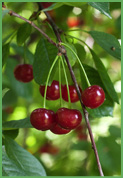
Cherry trees are a great fruit tree for your back yard. With the cultivation of so many varieties, there is a cherry for everyone. Sour cherries are self-fruiting and have no pollination issues if there is only one tree. They are a relatively easy tree to take care of, only requiring nutrients in the spring and pruning after the picking season is over.
Good companion plants for the cherry tree include garlic, onion, tansy, and nasturtiums to keep the pests away. The garlic is known to help repel rabbits, aphids, spider mites, apple scab, borers, peach leaf disease, Japanese beetles, spider mites, ants, cabbage looper, and cabbage maggots. Potatoes are prone to blight if planted in the vicinity of cherry trees. Wheat will also do poorly if planted close to cherry trees.
Elderberry
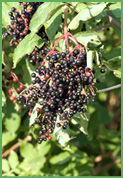
The elderberry shrub can easily reach 16 feet. The bush does prefer a moist soil so plant with peat moss or in a hollow where it can hold the moisture. The plant will bloom in May and June, producing clusters of small white flowers. The elderberry flower resembles the Queen Anne’s lace flowers. After flowering, the shrub will produce edible, small, black berries that make lovely jelly, preserves, and wine. One of the newest varieties, the Black Lace elderberry, offers maple-like lace foliage that provides a stunning display of dark red to black foliage and produces pink flowers.
The elderberry is often planted just to attract wildlife, making it an excellent companion plant for any garden. The flowers attract butterflies. Many birds eat the berries including the Eastern Bluebird, Blue Jay, Eastern Kingbird, European Starling, Brown Thrashers, Cedar waxwings, woodpeckers, Tufted Titmouse, and robins. Mice also enjoy the seeds. Rabbits and woodchucks are known to eat the bark while deer will eat the leaves and twigs.
Grapes
There are so many varieties of grapes available for such different purposes that you need to consult with your nursery professional for the right one. Some are self-seeding so you only need one plant for a high yield, while others require more plants for cross-pollination. Once you have the varieties you want, be sure to plant in full-sun with well-drained soil with a pH around 5.5. Grapes benefit from southern exposure. Plant in loose, loamy soil that has been well dug over. They need compost and mulch to grow well, and they will also need a trellis or some kind of climbing support. They can be trained to grow across most fence-like structures such as arbors. Also, consider the purple-leaf grape, which is popular for its purple foliage, that turns hot red in fall. It produces small quantities of fruit.
Good companion plants for grapes include basil, beans, oregano, geranium, clover, peas, and blackberries. Hyssop will increase the vine’s yield. Planting clover will set the nitrogen in the soil, but you should mow it flat before it goes to flower to keep it in control. Chives will help repel aphids. Other companion ideas include planting the vines under elm and mulberry trees. Bad companions include radishes, cabbage plants, and cypress spurge. Legumes work well for interplanting.
Melons
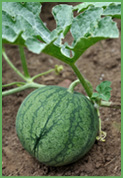
The term melon here applies to honeydew, cantaloupe, muskmelon, and watermelons. Melons will grow in most of the United States, although you may need to protect them if a frost warning comes and the fruit is almost ripe. The plants need full sun and they can be started from seed if you are in a warmer climate or may wish to purchase started plants from nurseries if you live in a shorter growing season area. Give them a location that is protected from wind and plant in hills after the last frost. Plant them 4 feet apart or only 2 feet apart if they are a bush variety.
Melons are good companions to radishes, pumpkin, peanuts, sunflower, squash, and corn. Nasturtium will help to deter bugs and beetles, and oregano provides general pest protection. Marigold helps to deters beetles. Potatoes are bad companions for this plant.
Passion Flower
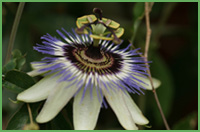
The passion flower is an exotic-looking plant for any garden and comes as both a shrub or vine. The plants can be started from seeds but are much easier to grow if you purchase young nursery stock. If choosing seeds, you will need to start them indoors where they will need a close eye on them so they do not totally dry out. After the last frost, transplant into the garden where the plant can climb, such as near a trellis or lattice. Unless you live in a very hot area, plant the passion flower in a full-sun location, otherwise a partial-shade location works well. They do well in most types of soil but prefer a light to sandy location. Passion flowers have delicate root systems so be careful when removing them from the pot. They will need regular watering as they can grow an inch a day and will use up fluids quickly; however, do not let the plant sit in water as the roots will rot. Once established, the plant will take off and bloom during the summer. The flowers come in a variety of colors including pink, lavender, red, white, and yellow shades. There are now several self-pollinating varieties as well. The oval fruit will ripen approximately 70 days after pollination.
The passion flower is known for attracting in pollinators like bees and wasps. It is also a great plant for bringing in butterflies and hummingbirds.
Peach
Peach trees attract birds and insects with their blossoms first and the sweet fruit later. Ants can be a problem, however. Plant basil at the base of the tree to stave off fruit flies. Use the strong scent of garlic and onions to keep other pests away. Tansy is another great addition around the tree as it repels most insects, including the peach-top moth and fruit flies. Nasturtium, pansies, alyssum, and marigolds make good flowers to plant at the base of the tree as well. The nasturtium will climb the trunk and help repel coddling moths.
Nectarines are peaches and will pollinate peaches if planted nearby and peach trees will increase the crops of the nectarine trees.
Good companion plants include horseradish, nasturtium, pansies, alyssum, marigolds, grapes, southernwood, and strawberries. Other good companions for peach trees include peas, clover, and beans as nitrogen fixers. Some herbs to plant at the base include borage to attract bees and add trace minerals to the soil, chamomile, and comfrey, which adds minerals to the soil at the end of their life cycle. Garlic is always good to have close by as it is known to repel many insects including borers, aphids, ants, cabbage loopers, and cabbage maggots, as well as stave off peach curl disease. Poor companions include potato, tomato, and raspberries.
Pear
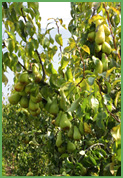
Pears are a hardy fruit tree that it is easy to grow. They do like a nitrogen-rich soil so add in manure and compost for a healthy producing tree. Try to produce an earlier crop by planting dandelions and feverfew around the base of the plant because they will bring in major pollinators earlier to the tree for an earlier crop. Pear trees require little fertilization except nitrogen, so make sure you plant at least one nitrogen fixer, such as clover, beans, or peas, at the base of the tree. Plant garlic to repel many pests including borers, aphids, ants, cabbage maggots, and cabbage looper. Garlic has been thought to stave off peach curl disease as well.
Good companions for pear trees include borage, which brings in the pollinators, adds trace minerals to the soil, as well as increases the tree’s resistance to pests and disease. Nasturtium helps repel coddling moths. Plant foxglove to protect the tree from disease. Other good companions include onion, marigold, alyssum, pansy, garlic, and sweet woodruff. Pear trees do particularly well when planted close to currants.
Bad companion for pear trees are potatoes and grass because the roots give off an excretion that stops the roots of the pear tree from growing.
Plums
Plum trees are common back yard sight. They are an abundant producer and there is a variety available for most North American climates. They also benefit from many of the same companion planting tips of the apple tree. Basil wards off fruit flies and garlic and onion work to keep many of the other pests away. Garlic helps repel scab, peach leaf curl, ants, aphids, borers, Japanese beetles, spider mites, cabbage loopers, rabbits, and cabbage maggots. Tansy helps deter most insects including fruit flies. To help the nutrient level of the soil for the plum roots, plant nitrogen fixers like peas, clover, and beans and several plants that will add nutrients to the soil like borage, chamomile, and comfrey.
Good companion plants include horseradish, nasturtium, pansies, alyssum, marigolds, grapes, southernwood, and strawberries. Apricots make poor companions for this plant.
Quince
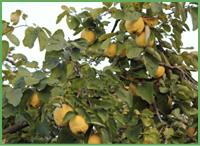
The flowering quince is another beautiful plant that is often grown for its ornamental qualities over the fruit it produces. The shrub grows 6 to 10 feet high and approximately the same width. The foliage starts as a bronze-red then turns to dark, glossy, green color. The plant likes a full or partial-sun but can grow well in partial-shade only it will produce less flowers. The plant is tough and hardy and will grow throughout most of the United States. In the fall, the shrub will produce red, pink, or white flowers followed by 2-inch, edible, apple-shaped fruit.
This shrub makes a great ornamental focal point, and as it does fine in shade, it can be planted under tall trees. Companion plants for the flowering quince include forsythia, day lilies, and irises as both will do better when together. The plant is known for attracting birds, especially hummingbirds.
Raspberries
There are summer- and ever-bearing raspberries. Summer bearing mean the raspberries will produce berries in the summer whereas ever-bearing means the raspberries produce for a longer period of time. Most raspberries require soil that is close to neutral with a pH of 6.5. The summer-bearing variety will produce fruit in early summer then stop producing fruit and put all their energy into new plant growth. The ever-bearing varieties will produce berries in spring and fall. Purchase the raspberry plants (canes) and plant in acidic soil late in spring after the last frost. Plant in a sunny location several feet apart. Cut the canes back to 6 inches high. Do not plant purple raspberries together with black raspberries; they have to be at least 600 feet apart or the varieties can cross pollinate.
A good companion for the raspberry bushes is tansy as it is great for repelling insects and will also help the bushes grow faster with better yields. Other good companions include turnips, yarrow, garlic, wormwood, and lavender. Bad companions include blackberries and Logan berries. Raspberries are bad companions for potatoes, making the potatoes more susceptible to blight.
Strawberries
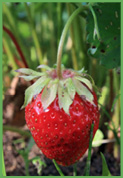
There are June-bearing and ever-bearing strawberry varieties available for home gardens. These are the common garden plants and are not to be confused with the strawberry bush from the euonymus family. Strawberries need a site that has full sun, warms up early, and allows good drainage. Plant the strawberry plants in a slightly acidic soil (around 6 pH) deep enough that just the crown shows above ground. Plant them 18 inches apart in rows that are 3 to 4 feet apart. They do well if hilled with compost or mulch.
Good companions for strawberries include beans, lettuce, spinach, onions, sage, and marigolds. Borage will help strengthen the plant’s resistance to insects and disease as well as bring in the honeybees. White hellebore will control sawflies. Thyme is perfect as a border as it deters worms. Pyrethrum will also keep many of the insects away. Bad companions include cabbage, broccoli, Brussels sprouts, cauliflower, kohlrabi, and gladiolas.
